에니어그램의 지혜 - 나와 세상을 이해하는 아홉 가지 성격 유형, 개정판
돈 리차드 리소,러스 허드슨 (지은이),
주혜명 (옮긴이)한문화2009-03-10
원제 : The Wisdom of the Enneagram: The Complete Guide to Psychological and Spiritual Growth for the Nine Personality Types
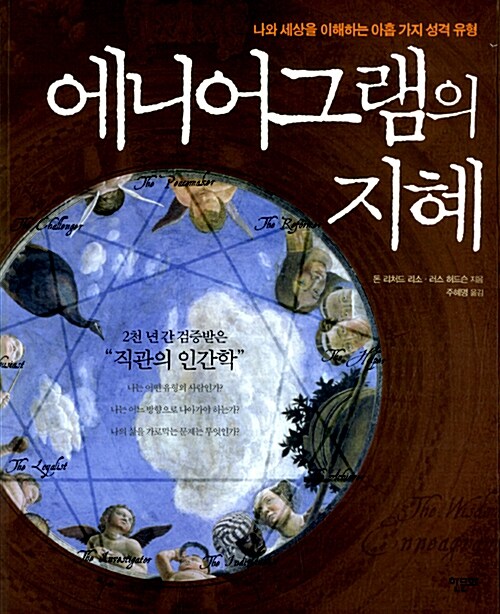
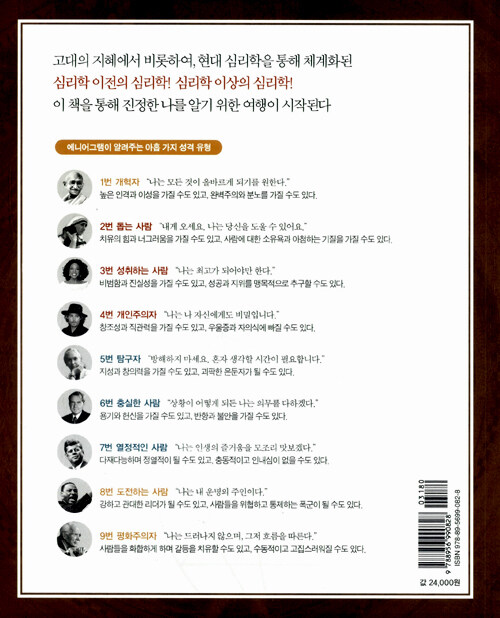


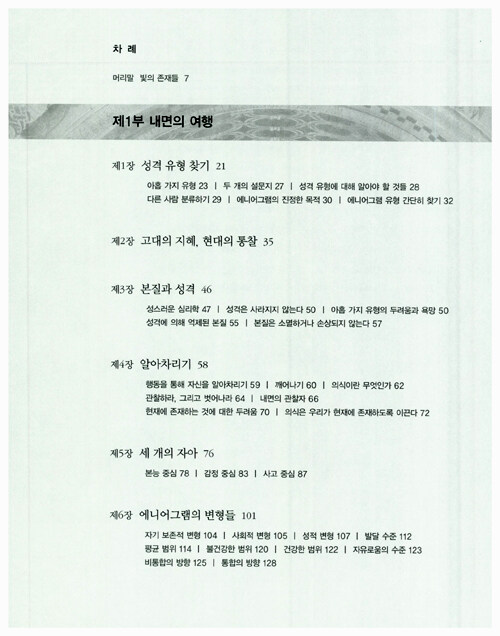



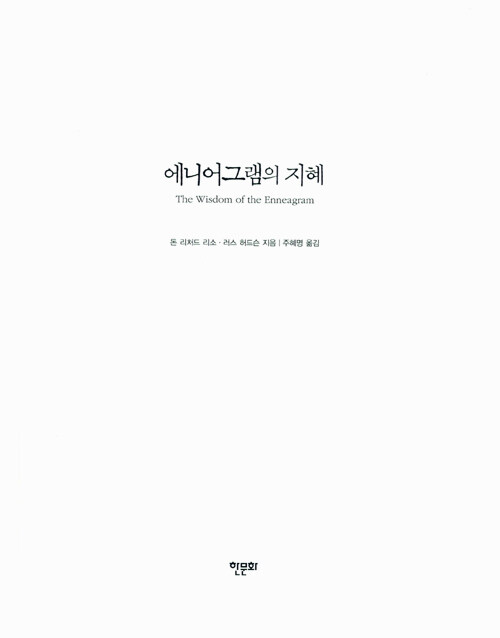

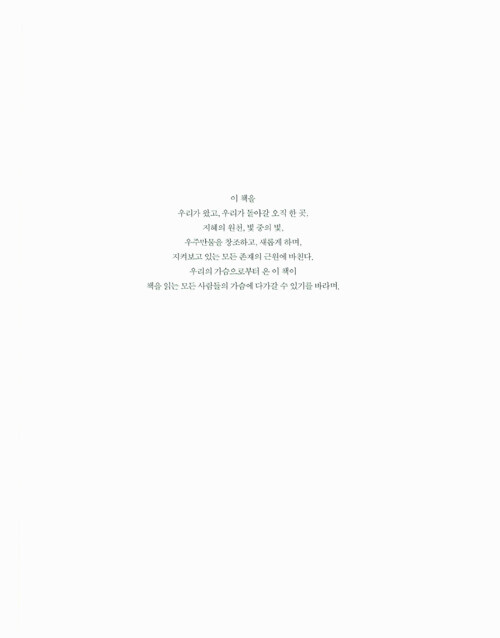

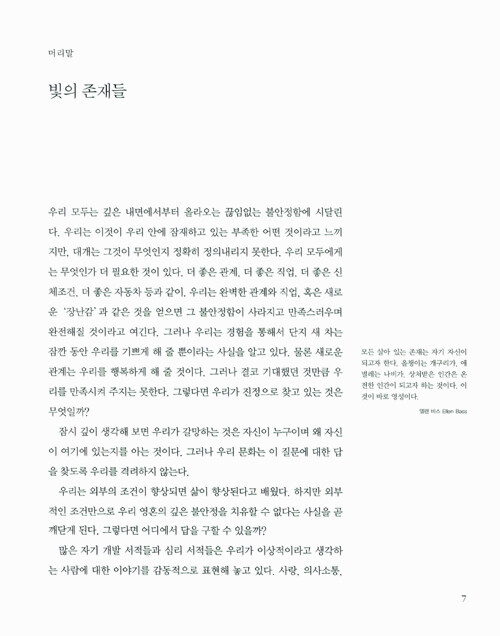



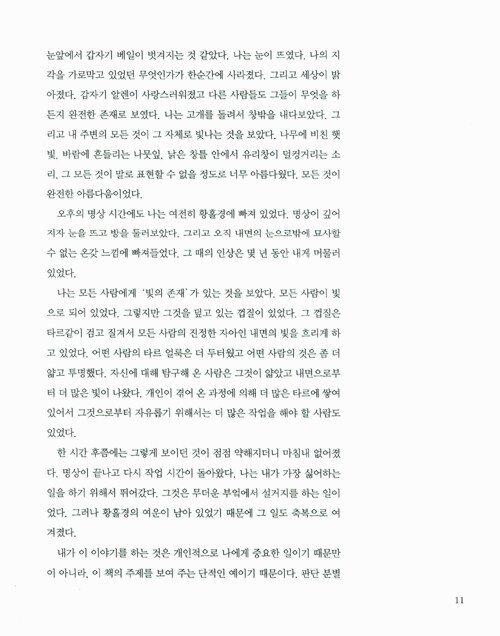



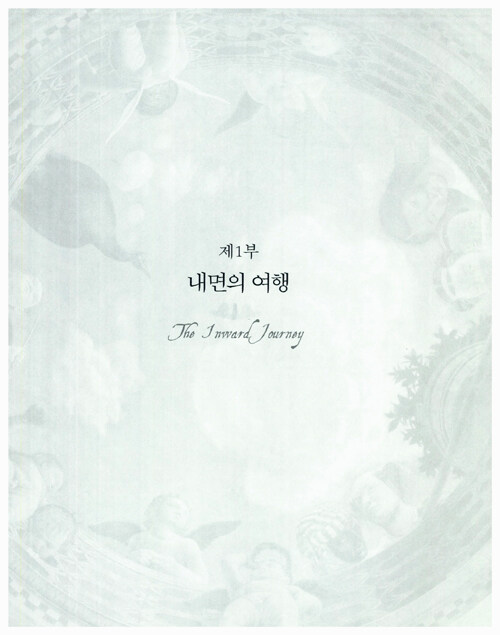

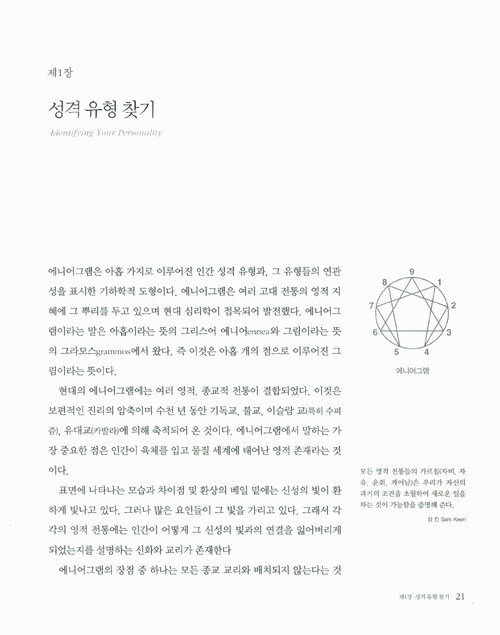

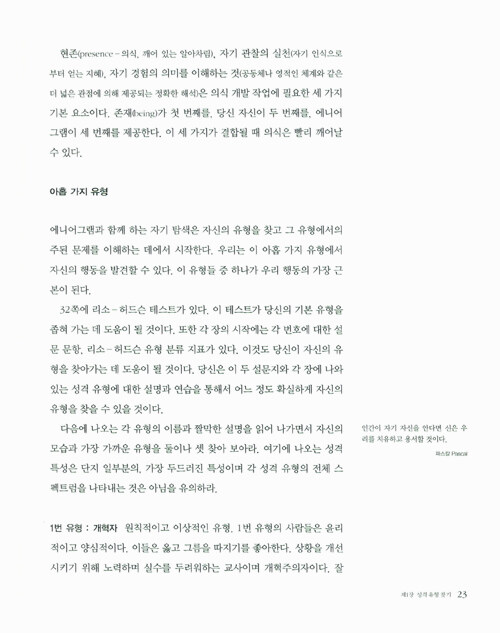


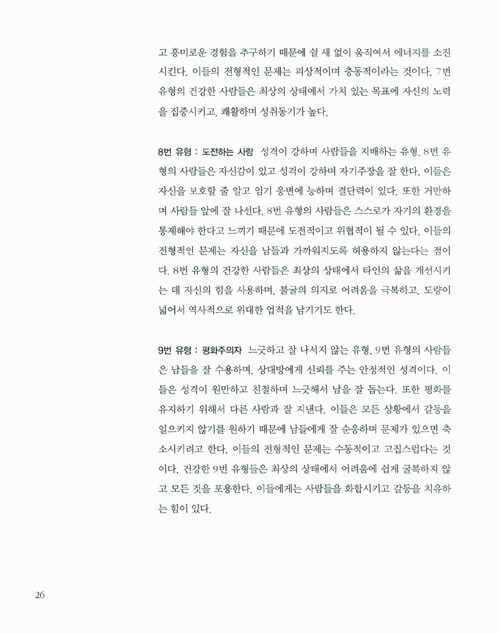




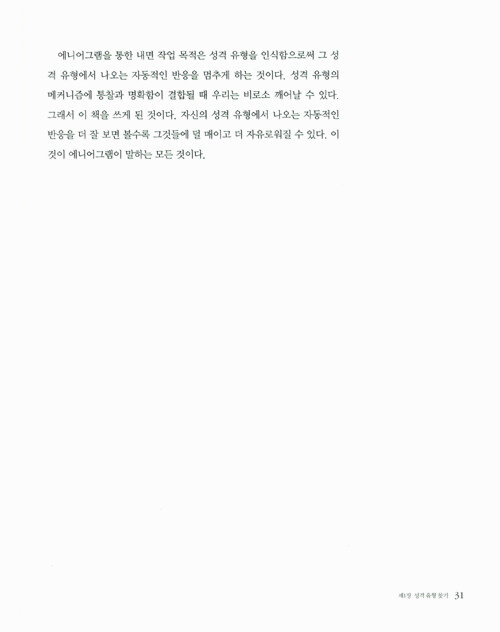


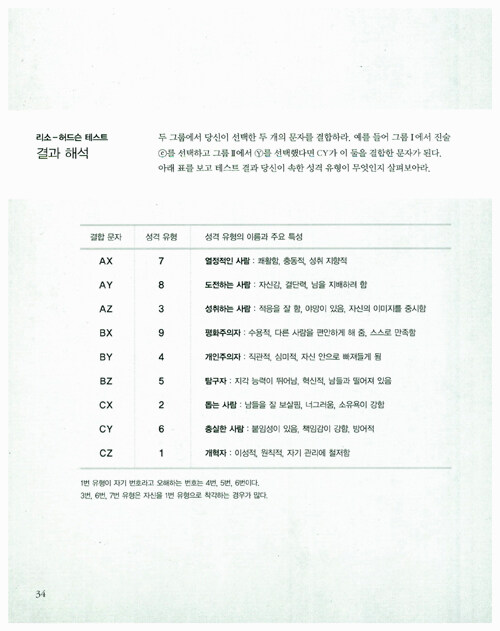




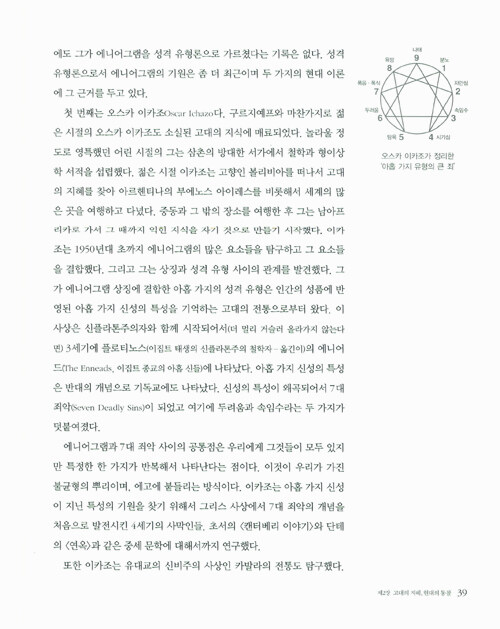
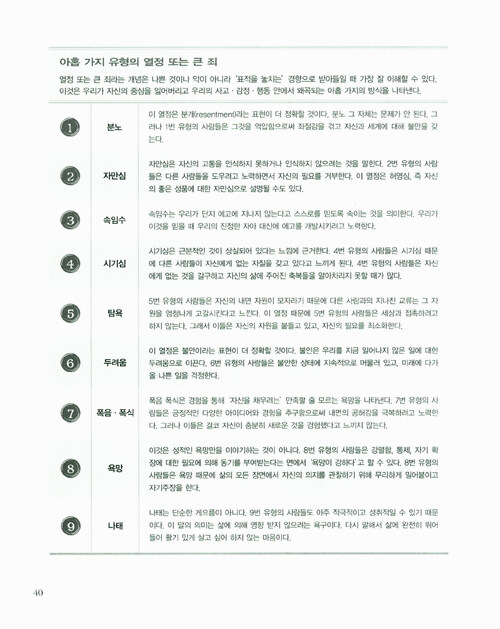
 미리보기
미리보기
정가
24,000원
판매가
21,600원 (10%, 2,400원 할인)
마일리지
1,200원(5%) + 멤버십(3~1%)
+ 5만원이상 구매시 2,000원
배송료
무료
Sales Point : 3,178
 9.2 100자평(23)리뷰(11)
9.2 100자평(23)리뷰(11)
이 책 어때요?
카드/간편결제 할인
무이자 할부
소득공제 980원
구판절판 개정판 출간에 따라 유통중단, 개정판 구입만 가능합니다.
절판
보관함 +
 The Wisdom of the Enneagram: The Complete Guide to Psychological and Spiritual Growth for the Nine Personality Types (Paperback) Paperback
The Wisdom of the Enneagram: The Complete Guide to Psychological and Spiritual Growth for the Nine Personality Types (Paperback) Paperback
책소개
에니어그램은 그리스어로 ‘9’를 뜻하는 ‘에니어(ennea)'와 ‘그림’을 뜻하는 ‘그램(gram)’의 합성어로 ‘아홉 개의 점이 있는 그림’을 말한다. 원과 아홉 개의 점, 그리고 그 점들을 잇는 선으로만 구성이 된 단순한 도형이지만 그 안에는 우주 법칙과 인간 심리의 모든 것이 함축되어 있기에 고대 사회에서는 지도자 육성 매뉴얼로서 몇몇 사람에게만 비밀리에 전해졌다고 한다.
이처럼 고대의 지혜에서 비롯한 에니어그램은 이후에도 다양한 종교 전통과 어우러졌고 20세기 들어서는 심리학과 결합하여 독특하고 심오한 성격유형론으로 재탄생했다. “인간은 아홉 가지의 성격 유형으로 분류되며 어떤 사람이라도 그 중 하나를 가지고 태어난다.” 이것이 에니어그램의 기본 원리다. 남녀가 거의 반반의 비율로 태어나듯 세계 모든 지역에서 각 타입의 숫자는 아홉으로 균등하게 나누어진다고 한다.
목차
머리말
제1부 내면의 여행
제1장 성격 유형 찾기
아홉 가지 유형 / 두 개의 설문지 / 성격 유형에 대해 알아야 할 것들 / 다른 사람 분류하기 / 에니어그램의 진정한 목적 / 에니어그램 유형 간단히 찾기
제2장 고대의 지혜, 현대의 통찰
제3장 본질과 성격
성스러운 심리학 / 성격은 사라지지 않는다 / 아홉 가지 유형의 두려움과 욕망 / 성격에 의해 억제된 본질 / 본질은 소멸하거나 손상되지 않는다
제4장 알아차리기
행동을 통해 자신을 알아차리기 / 깨어나기 / 의식이란 무엇인가 / 관찰하라, 그리고 벗어나라 / 내면의 관찰자 / 현재에 존재하는 것에 대한 두려움 / 의식은 우리가 현재에 존재하도록 이끈다
제5장 세 개의 자아
본능 중심 / 감정 중심 / 사고 중심
제6장 에니어그램의 변형들
자기 보존적 변형 / 사회적 변형 / 성적 변형 / 발달 수준 / 평균 범위 / 불건강한 범위 / 건강한 범위 / 자유로움의 수준 / 비통합의 방향 / 통합의 방향
제2부 아홉 가지 성격 유형
제7장 1번 유형 : 개혁자
1번 유형 : 개혁자 / 어린 시절의 패턴 / 9번 날개를 가진 1번 - 이상주의자 / 2번 날개를 가진 1번 - 사회운동가 / 자기 보존 본능의 1번 유형 / 사회적 본능의 1번 유형 성적 본능의 1번 유형 / 1번 유형을 일깨우는 신호 - 강한 의무감 / 1번 유형의 타고난 장점 / 본질이 드러남
제8장 2번 유형 : 돕는 사람
2번 유형 : 돕는 사람 / 어린 시절의 패턴 / 1번 날개를 가진 2번 - 봉사자 / 3번 날개를 가진 2번 - 안주인 / 자기 보존 본능의 2번 유형 / 사회적 본능의 2번 유형 / 성적 본능의 2번 유형 / 2번 유형을 일깨우는 신호 - 남들의 기분에 맞추기 / 본질이 드러남
제9장 3번 유형 : 성취하는 사람
3번 유형 : 성취하는 사람 / 어린 시절의 패턴 / 2번 날개를 가진 3번 - 매력적인 사람 / 4번 날개를 가진 3번 - 전문가 / 자기 보존 본능의 3번 유형 / 사회적 본능의 3번 유형 / 성적 본능의 3번 유형 / 3번 유형을 일깨우는 신호 - 나의 가치는 나의 성공에 달렸다 / 본질이 드러남
제10장 4번 유형 : 개인주의자
4번 유형 : 개인주의자 / 어린 시절의 패턴 / 3번 날개를 가진 4번 - 귀족 / 5번 날개를 가진 4번 - 보헤미안 / 자기 보존 본능의 4번 유형 / 사회적 본능의 4번 유형 / 성적 본능의 4번 유형 / 4번 유형을 일깨우는 신호 - 상상을 통해 감정을 강화하기 / 본질이 드러남
제11장 5번 유형 : 탐구자
5번 유형 : 탐구자 / 어린 시절의 패턴 / 4번 날개를 가진 5번 - 인습 타파주의자 / 6번 날개를 가진 5번 - 문제 해결자 / 자기 보존 본능의 5번 유형 / 사회적 본능의 5번 유형 / 성적 본능의 5번 유형 / 5번 유형을 일깨우는 신호 - 생각 속으로 은둔하기
본질이 드러남
제12장 6번 유형 : 충실한 사람
6번 유형 : 충실한 사람 / 어린 시절의 패턴 / 5번 날개를 가진 6번 - 방어하는 사람
7번 날개를 가진 6번 - 친구 / 자기 보존 본능의 6번 유형 / 사회적 본능의 6번 유형
성적 본능의 6번 유형 / 6번 유형을 일깨우는 신호 - 확실한 것 찾기 / 본질이 드러남
제13장 7번 유형 : 열정적인 사람
7번 유형 : 열정적인 사람 / 어린 시절의 패턴 / 6번 날개를 가진 7번 - 엔터테이너
8번 날개를 가진 7번 - 현실주의자 / 자기 보존 본능의 7번 유형 / 사회적 본능의 7번 유형 / 성적 본능의 7번 유형 / 7번 유형을 일깨우는 신호 - “남의 풀밭의 풀이 항상 더 푸르다!” / 본질이 드러남
제14장 8번 유형 : 도전하는 사람
8번 유형 : 도전하는 사람 / 어린 시절의 패턴 / 7번 날개를 가진 8번 - 독립적인 사람 / 9번 날개를 가진 8번 - 곰 / 자기 보존 본능의 8번 유형 / 사회적 본능의 8번 유형
성적 본능의 8번 유형 / 8번 유형을 일깨우는 신호 - 자기 충족을 위한 투쟁 / 본질이 드러남
제15장 9번 유형 : 평화주의자
9번 유형 : 평화주의자 / 어린 시절의 패턴 / 8번 날개를 가진 9번 - 중재하는 사람
1번 날개를 가진 9번 - 몽상가 / 자기 보존 본능의 9번 유형 / 사회적 본능의 9번 유형 성적 본능의 9번 유형 / 9번 유형을 일깨우는 신호 - 남과 잘 지내기 / 본질이 드러남
제3부 의식 변형을 위한 도구
제16장 영적 성장을 향한 실천
영적 성장을 위한 다양한 수행 방식/ 의식 성장을 위한 일곱 가지 도구 / 수퍼에고 다루기 / 몸 다루기 / 고요한 마음 개발하기 / 가습 열기 / ‘놓아 버림’의 에니어그램
제17장 영적인 여행 - 언제나 지금
고통 놓아버리기 / 진정한 자아 발견하기 / 성격을 넘어서
옮긴이의 말
참고 문헌
접기
책속에서
에니어그램이 제공해 줄 수 있는 가장 중요한 통찰은 우리가 우리의 성격은 아니라는 깨달음이다. 우리는 이 말을 이해하기 위해서 자신에 대한 인식이 변화되는 경험을 해야 한다. 자신이 자신의 성격이 아니라는 것을 이해할 때 비로소 우리는 스스로가 성격을 ‘가지고’ 있으며, 그 성격을 통해서 우리 자신을 표현하는 영적인 존재임을 깨닫게 된다. 우리가 스스로를 성격과 동일시하기를 멈추고 자신의 성격을 방어하기를 멈출 때 기적이 일어난다. 우리의 본질이 자연스럽게 드러나서 우리를 바꾸는 것이다. - p.49 '제3장 본질과 성격' 중에서
구르지예프는 아주 이상한, 역설적인 말을 했다 - 인간이 가장 나중에 놓아 버리는 것은 고통이다. 이것은 맞는 말일까? 그렇다면 왜일까? 첫째로 우리는 고통에 익숙하다. 이 사실은 우리가 아는 것이며 그래서 다른 알지 못하는 조건보다 더 안전하게 느껴지는 것이다. 둘째는 아마도 우리는 고통을 포기하면 뭔가 새롭고 더 나쁜 형태의 무언가가 우리를 장악할 것이라고 걱정하는 것 같다. (……) 우리의 정체성 중 많은 부분은 자신의 고통을 붙들고 있는 것으로부터 - 모든 불평, 긴장, 갈등, 비난, 합리화, 투사, 정당화, 그리고 고통을 허용하는 ‘에너지’로부터 - 온다. 이것이 우리 성격의 뿌리라고도 말할 수 있을 것이다. 그런데 만약 우리의 고통이 그리고 그것을 둘러싼 모든 것이 사라진다면 우리는 과연 누구일까? - p.481 '제17장 영적인 여행 - 언제나 지금' 중에서 접기
저자 및 역자소개
돈 리차드 리소 (Don Richard Riso) (지은이)
저자파일
신간알리미 신청
세계적인 에니어그램 지도자이자 가장 중요한 저술가. 13년간 예수회 수사로 일했으며 공동저자인 러스 허드슨과 함께 에니어그램연구소(The Enneagram Institute)를 설립해 수십 년간 에니어그램에 관한 연구를 진행해왔다. 리소의 연구와 가르침은 현대 에니어그램의 확립에 핵심적인 역할을 했으며, 저서들이 한국을 포함한 수많은 나라에 번역되어 있다. 국제에니어그램협회와 Enneagram Personality Types, Inc.를 설립하여 에니어그램의 대중화에도 기여했다. 스탠포드대학 포드재단의 연구원으로 일했고, 2012년 66세를 일기로 작고했다. 접기
최근작 : <에니어그램의 이해>,<에니어그램의 지혜>,<에니어그램의 이해> … 총 25종 (모두보기)
러스 허드슨 (Russ Hudson) (지은이)
저자파일
신간알리미 신청
에니어그램 분야의 세계적인 학자이자 혁신적인 사상가. 리소와 함께 에니어그램연구소를 공동설립했다. 1991년부터 에니어그램을 보급하기 위해 에니어그램 트레이닝 프로그램을 가르치고 있다. 국제에니어그램협회의 설립 이사이자 부사장을 역임하였다.
리소와 『Personality Types: Using the Enneagram for Self-Discovery』, 『Understanding the Enneagram』, 『Enneagram Transformations』, 『Discovering Your Personality Type』, 『He Wisdom of the Enneagram』 등을 공동으로 저술하였다. 접기
최근작 : <에니어그램의 이해>,<에니어그램의 지혜>,<에니어그램의 이해> … 총 24종 (모두보기)
주혜명 (옮긴이)
저자파일
신간알리미 신청
성균관대학교 교육학과를 졸업하고 한서대학교 대학원 심신건강증진학과에서 수학했으며 서울불교대학원대학교 상담심리학과 박사 과정을 수료했다. 조선대학교 대체의학과 초빙객원교수를 역임하고 현재 의식개발 프로그램 아봐타 마스터, 고려대학교 의과대학 통합의학교실 연구교수로 재직 중이다.
옮긴 책으로 <돈을 끌어오는 마음의 법칙>, <나를 찾는 에니어그램, 상대를 아는 에니어그램> 등이 있다.
최근작 : <당신이 바로 하늘이 낸 부자일지도 모른다> … 총 14종 (모두보기)
출판사 소개
한문화
도서 모두보기
신간알리미 신청
최근작 : <힐링 소사이어티>,<세상에 없던 아이들이 온다>,<내가 나를 어쩌지 못한다면>등 총 127종
대표분야 : 심리학/정신분석학 17위 (브랜드 지수 61,902점)
출판사 제공 책소개
에니어그램은 그리스어로 ‘9’를 뜻하는 ‘에니어(ennea)'와 ‘그림’을 뜻하는 ‘그램(gram)’의 합성어로 ‘아홉 개의 점이 있는 그림’을 말한다. 원과 아홉 개의 점, 그리고 그 점들을 잇는 선으로만 구성이 된 단순한 도형이지만 그 안에는 우주 법칙과 인간 심리의 모든 것이 함축되어 있기에 고대 사회에서는 지도자 육성 매뉴얼로서 몇몇 사람에게만 비밀리에 전했다.
이처럼 고대의 지혜에서 비롯한 에니어그램은 이후에도 다양한 종교 전통과 어우러지면서 발전을 거듭했고 20세기 들어서는 심리학과 결합하여 독특하고 심오한 성격유형론으로 재탄생했다. “인간은 아홉 가지의 성격 유형으로 분류되며 어떤 사람이라도 그 중 하나를 가지고 태어난다.” 이것이 에니어그램의 기본 원리다. 남녀가 거의 반반의 비율로 태어나듯 세계 모든 지역에서 각 타입의 숫자는 아홉으로 균등하게 나누어진다고 한다.
현재 에니어그램은 구도의 길을 찾는 종교인들을 비롯하여 직장인, 학생, 주부에 이르기까지 많은 사람들이 생활이나 업무 수행의 지침으로 삼고 있을 정도로 일반화 되어 있다. 특히 대기업의 신입사원 채용과 인사 관리, 조직 운용 등에 필수적인 자료가 되었으며 제너럴 모터즈, AT&T를 비롯해 많은 대기업들이 그 효과를 실증하고 있다.
에니어그램이 알려주는 아홉 가지 성격 유형
1번 개혁자 “나는 모든 것이 올바르게 되기를 원한다.”
높은 인격과 이성을 가질 수도 있고, 완벽주의와 분노를 가질 수도 있다.
예) 간디, 소로, 촘스키, 힐러리 클린턴, 셀린 디온, 엠마 톰슨, 존 바에즈
2번 돕는 사람 “내게 오세요. 나는 당신을 도울 수 있어요.”
치유의 힘과 너그러움을 가질 수도 있고, 사람에 대한 소유욕과 아첨하는 기질을 가질 수도 있다.
예) 마더 테레사, 엘리노어 루즈벨트, 나이팅게일, 슈바이처, 존 덴버
3번 성취하는 사람 “나는 최고가 되어야만 한다.”
비범함과 진실성을 가질 수도 있고, 성공과 지위를 맹목적으로 추구할 수도 있다.
예) 오프라 윈프리, 빌 클린턴, 톰 크루즈, 마돈나, 리처드 기어, 마이클 조던
4번 개인주의자 “나는 나 자신에게도 비밀입니다.”
창조성과 직관력을 가질 수도 있고, 우울증과 자의식에 빠질 수도 있다.
예) 조니 뎁, 에드가 알렌 포, 실비아 플라스, 테네시 윌리암스, 밥 딜런
5번 탐구자 “방해하지 마세요. 혼자 생각할 시간이 필요합니다.”
지성과 창의력을 가질 수도 있고, 괴팍한 은둔자가 될 수도 있다.
예) 제인 구달, 스티븐 호킹, 데이빗 린치, 팀 버튼, 반 고흐, 빌 게이츠, 찰스 다윈
6번 충실한 사람 “상황이 어떻게 되든 나는 의무를 다하겠다.”
용기와 헌신을 가질 수도 있고, 반항과 불안을 가질 수도 있다.
예) 리처드 닉슨, 말콤 X, 멜 깁슨, 톰 행크스, 다이애나 전 왕세자비
7번 열정적인 사람 “나는 인생의 즐거움을 모조리 맛보겠다.”
다재다능하며 정열적이 될 수도 있고, 충동적이고 인내심이 없을 수도 있다.
예) 존 F. 케네디, 로빈 윌리엄스, 스필버그, 모차르트, 벤자민 플랭클린
8번 도전하는 사람 “나는 내 운명의 주인이다.”
강하고 관대한 리더가 될 수도 있고, 사람들을 위협하고 통제하는 폭군이 될 수도 있다.
예) 마틴 루터 킹, 고르바초프, 루즈벨트, 프랭크 시내트라, 숀 코너리, 폴 뉴먼
9번 평화주의자 “나는 드러나지 않으며, 그저 흐름을 따른다.”
사람들을 화합하게 하며 갈등을 치유할 수도 있고, 수동적이고 고집스러워질 수도 있다.
예) 칼 융, 오드리 헵번, 레이건, 케빈 코스트너, 우피 골드버그, 링컨 접기
북플 bookple
이 책의 마니아가 남긴 글
친구가 남긴 글
내가 남긴 글
친구가 남긴 글이 아직 없습니다.
마니아
읽고 싶어요 (1)
읽고 있어요 (11)
읽었어요 (66)
이 책 어때요?
구매자
분포

0.7% 10대

0.3%

11.7% 20대

5.4%

25.7% 30대

8.4%

27.5% 40대

9.7%

6.1% 50대

3.8%

0.3% 60대

0.5%
여성 남성
평점
분포





9.2





애내어그램의 지혜 아직 다읽지는 않았지만 읽기 편하게 되여있네요.

민들레 2010-01-14 공감 (6) 댓글 (0)
Thanks to
공감





신세계

정유정 2010-05-12 공감 (1) 댓글 (0)
Thanks to
공감





한국식 에니어그램은 잘 맞지도 않고 창시자 구르지예프의 철학이 전혀 함유돼 있지도 않다. 차라리 이책이 가장 뛰어난 해설서이자 지침서이다. 덧붙이자면 에니어그램은 인생을 새롭게 맞고 싶은 이에게 필요하고 적절하다.예컨대 중년의 위기를 겪고 계신 분이라면 강추다.물론 더 일찍보면 짱!!

별을심는사람 2014-12-06 공감 (0) 댓글 (0)
Thanks to
공감





다 납득이 가지는 않지만, 9개의 성격유형을 알 수 있는 책..

redomt 2011-02-28 공감 (0) 댓글 (0)
Thanks to
공감





서점에서 봤는데 자세하게 나와있어서 구매했네요

산타메이 2015-06-13 공감 (0) 댓글 (0)





‘에니어그램’ 분야에서 (현재) 최고로 탁월한 번역서
나는 때로는 입을 조용히 다물고 듣기에 집중하고 싶다고 생각하곤 했다. 나는 무슨 말이든 시작하면 이렇고 저렇고 하며 분석한 이야기를 꺼내는 내가 싫었다. 특히 내 행동을 분석하고, 내 생각을 분석한 이야기를 나누는 내 모습을 보고 싶지 않아서 내 생각을 반 정도만 말하기로 다짐했었다. 그러나 얼마간이 지났을 때엔 정말 반 정도밖에 내 생각을 이야기하지 못하는 소통의 어려움을 겪는 나를 발견하였다. – 한 일본 소설의 주인공이 같은 모습을 보여주었고, 나의 생각을 언어로 정리해주었기에 내가 나를 발견할 수 있었을 게다. – 그러나 나는 아직도 그렇게 살고 있다. 감정적인 부분보다는 사실 위주로 이야기를 하며, 그렇기에 덧붙이는 감정의 언어는 늘 비슷비슷하고 식상하여 표현하면서도 나의 표정은 밝지 않다. 설사 좋은 이야기를 할 때에도 속으로는 다른 언어로 토해내지 못하는 답답함을 느끼고 있다. 이런 나는 5번이다.
에니어그램을 처음에는 재미로 시작하였다. 열심히 파보려는 의지도 없었고 에니어그램을 아는 사람들과 대화를 나눌 때 동참하기 위한 정도로 읽고 어정쩡하게 5번이라는 결론을 얻고 잊고 살았다. 이번에 함께 읽으면서 깊게 접하였다. 4번인 친구가 온 몸으로 느끼며 읽으며 끊임없는 대화를 시도해준 덕분에 진지하게 읽었다. 책 표지에 있는 표정 없는 사람들이 주는 위압감은 그럭저럭 해소되었지만 결론적으로 마지막 3부는 건성거렸다. 마치 수련원에라도 온 기분이 들어서.
역자도 솔직히 밝히고 있다. 다양한 사람들을 9종으로 묶는 유형화에 대한 첫 반발심에 대해. 그러나 역자는 그것을 뛰어 넘고 온전한 단계에 이르는 충만함을 맛본 자로 과거에 대해 이야기하지만 개인적으로 생각할 때 많은 사람들이 ‘자가 분석’에서 멈춘다. 자신의 유형을 발견하기 위해 열심히 각 유형에 대해 파헤쳐 본 후에 그 유형에 심취한 후 끝나 버리는 사례가 많다. 이 책에서 저자가 강력하게 주의를 주는 부분임에도 불구하고. 왜 그럴까? 의식적으로 고통을 더 느끼길 원하는(?) 인간의 본성 덕분일까? 책의 1부, ‘내면의 여행’에서는 희망찬 시작을 연다. 나를 앎으로, 더 깊은 나의 내면과 조우함으로 자유로워질 수 있다고, 모두가 마음 속 깊이 열망하는 ‘자유’로 우리를 이끌고 있다. 그리고 2부에서 각자의 유형에 대해 심도 있는 분석을 해준다. 점쟁이를 앞에 두고 복채 값이 올라가는 기분을 느낄 정도이다. 그런데 문제는 이것이 은근히 사람 속을 긁는다는 것이다. 나를 너무 잘 아는 사람에게서 듣는 칭찬이라기 보다는 까발려진다는 기분? 이것이 더 정확한 감정일 테다. 용하긴 한데 마음 참 쓰리다 싶으면 이제 3부에서 진정을 시켜주려 한다. 계속 점쟁이 이야기로 끌어가는 것은 내 타입이 아니긴 한데, 이왕 시작한 김에 이어가야겠다. 대개 우리의 두려움을 잠재워주는 것이 부적 아니겠는가? 3부, ‘의식의 변형을 위한 도구’는 따지고 보면 그런 식이다. 값도 꽤 비싸다. 이 책을 들쳐본 이유가 내가 다 아는 사실들로 확인사살 하자는 것은 아닐 테다. 자기 계발 서적을 집는 사람들, 나를 알아가는 여행을 계획하는 사람들의 출발점은 대개 ‘지금의 나, 이렇게는 안 된다.’일 테다. 그래서 의지를 갖고 움직여야 함이다. 한 단어로 줄이면 ‘실행’이다.
예를 들어 가만히 앉아서 명상하는 5번은 명상을 하되 걸으면서, 좀 움직이면서 하라고 다그친다. 고요함에서 힘을 얻는 5번, 그러나 그 고요함에 빠져 버리는 오류를 범하는 5번에게, 그러니깐 당신 5번은 대중들 틈에 가는 극복 연습을 해야 합니다 라고 우울한 해결책을 주지는 않는다. 실행하되 내가 안 되는 부분을 계속 건드려서 강하게 만들려고 시도하다가 중도 포기하지 말고 수퍼 에고를 달래주면서 불필요한 메시지를 줄이면서 본질을 향해 가는 길을 안내하고 있다.
안타까운 것은 변화는 ‘매일의 증거’라는 것이다. 나를 아는 것이 자유로워질 수 있다는 것은 내 모든 행동 또는 두려움들에 정당성을 부여하는 것이 아니라 그것을 뛰어 넘을 수 있는 힘을 주는 진정한 ‘자유’를 갖게 된다는 의미라고 생각한다.
혼자 여행을 가끔 떠나곤 하는 내게 사람들이 많이 물어본다. 두렵지 않은지, 외롭지 않은지. 나는 늘 대답한다. 엄청 무섭고 외롭고 두렵다고. 얼마 전 친구가 처음으로 혼자 부산으로 1박 2일 일정의 여행을 갔다가 당일 저녁에 돌아왔다. 생각보다 빨리 왔구나 라는 내 질문에 친구는 대답했다. 생각보다 재미없고 할 일이 없었다고.
“이틀을 넘기지 않았기 때문이야.”
많은 사람들이 혼자 여행을 떠나면 그 순간부터 엄청난 자유로움을 느낄 것이라는 기대를 한다. 그럴 때도 있다. 그러나 내가 배운 자유는 그렇게 처음부터 끝까지 함박웃음 짓는 것이 아니었다. 어느새 슬그머니 지어지는 미소, - 바로 이것이 자아를 발견한 다음에 찾아오는, 그러나 어쩌면 한참 뒤에 또는 매일매일 짧은 순간씩만 찾아오는 자유의 기쁨이 아닐까 생각해본다.
<< 스크롤 압박 - "본문 기억하기" 파트를 보시려면... http://blog.naver.com/metheusyun/90039610254 >>
- 접기
카프카 2009-04-16 공감(12) 댓글(0)
Thanks to
공감





성격에서 영성으로
요새 내 주된 관심사 중 하나는 심리학과 영적 탐구의 조화를 추구하는 것이다. 좀 거창하게 말하자면 과학과 종교, 서양과 동양의 통합이라고 할까? 성격은 심리학에서 주요한 주제로 다루는 것이지만, 영적 탐구에 있어서는 그다지 크게 주목하지 않는 것이다. 기본적으로 자아를 하나의 환영으로 보는 동양의 영적 전통에 있어서 성격은 중요한 것이 아니었다. 그러나 영적 탐구의 노정에서 성격은 출발점이면서 장애물이자, 궁극에 있어선 화해를 통한 극복의 대상이라 할 수 있다. 성격을 분석하는 여러 도구가 있지만 에니어그램은 기하학적 도형이 주는 신비감과 더불어 성격의 발달에 관한 역동적인 관점을 제공해 준다.
공저자인 돈 리처드 리소와 러스 허드슨은 <에니어그램의 지혜>를 통해서 단순히 에니어그램이란 성격유형 분석의 방법론만을 제공하는 것이 아니라, 자기 성격의 이해를 통해 어떻게 성격 너머에 존재하는 '우주적 본성'과 합일할 수 있는가란 영적인 문제까지 다루고 있다. 에니어그램이 보여주는 아홉가지 성격 유형은 우리가 잃어버린 본성과의 연결을 대신하기 위해 만들어진 것이라 한다. 성격이 본성을 대신하는 것이란 말이다. 성격이란 불완전한 대체물과의 동일시에서 벗어나기 위해선 무엇보다 성격 그 자체에 대한 '있는 그대로'의 이해가 필요하다. 성격의 개조나 행동의 교정이 필요한 것이 아니라, 자신의 감정과 생각에 의존하지 않고 지금 이 순간 이미 온전하게 존재하는 본성을 발견하는 것이 핵심이다. 들어온 문이 곧 나가는 문이 된다.
- 접기
몽지 2011-03-29 공감(2) 댓글(0)
Thanks to
공감





사람을 읽는 기술

낭만인생 2013-07-31 공감(1) 댓글(0)
Thanks to
공감





에니어그램 개론
11월 초에 두번에 걸쳐서 에니어그램에 관한 수업을 들었습니다.
홍정현씨가 수고 해주셨고 에니어그램에 대한 강연을 정리해보려 합니다.
에니어그램의 의미를 시작으로
유형별 장,단점을
유형별로 보는 영성지수에 따른 행동 패턴,
마지막으로 자신의 경향을 확인해볼수 있는 설문지 순으로 게제합니다.
에니어그램은 장점을 찾는 방법중 하나로 보시면 되실 듯합니다.
특히 선천적인 특성에 기인하게 됩니다.

그러면 어떻게 에니어그램을 사용해야 할까요?
바로 아래의 3단계를 거쳐서 활용하시면 됩니다.

다시한번 에니어그램에 대해서 정리해보고 유형별 특성을 정리해보면 다음과 같습니다.



자신의 특성을 찾는데 쉽는 방법은 자신이 두려워하는 것들로 유형을 찾는 것입니다.
다음은 각 유형들이 가지고 있는 두려움과 욕망입니다.

정리를 해보면 다음과 같습니다.

의식지수(영성지수)에 따른 유형별 행동 패턴입니다. 여기서 의식지수가 높을수록 건강한 영혼을 의미합니다. 자신의 행동과 비교해보시면 현재 어느정도의 의식지수를 아실 수 있습니다.

1유형 The Reformer
2유형 The Helper
3유형 The Achiever
4유형 The Individualist
5유형 The Investigator
6유형 The loyalist
7유형 The Enthusiast
8유형 The Challenger
9유형 The Peacemaker
마지막으로 자신의 에니어그램 유형을 알수 있는 설문지입니다.일치하시는 부분에 체크해주시고 제일 체크가 많은 순으로 3개가 님이 가지고 계시는 유형입니다. 주의하실점은 설문지의 가~자 유형은 1~9유형의 순번과 일치하지 않습니다. 해석하시는데 오해 없으시길 바랍니다.



- 접기
DreamPartner 2011-11-18 공감(1) 댓글(5)
Thanks to
공감





나름 괜찮았던 책......

나름 괜찮았다.
우선 에니어그램을 통하여, 인간의 성격의 유형과 다층성에 대한 기록, 그리고 그들이 겪는 발달 단계와 장단점을 읽어 내려가는 것을 통하여, 스스로 치유되어져 가는 것을 느낀다. 이 내용들에 대한 것은 "Present" 에 대한 것들.
사람들은 나르시즘과 환상, 과대망상을 만들어 놓고 그 안에서 살아간다. 안전하기 때문이다. 그렇기 때문에 현재 주어진 것들에 대해서 간과하며, 스스로의 실제 정체성을 부인하거나, 외도 하면서 살아가는 것이다. 우리에게 주어진 이 현재 시간을 살것에 대한 구체적인 지침이 마지막에 주어진다. 이것은 매우 중요하다. 이것을 한다면, 읽어버린 현재와 미래를 식민화 할려는 고약한 습성에서 나오는 미래에 대한 열망을 줄일수 있으리라.
현재......내 뒤에서 들려오는...귀뚜라미 소리와...티비소리. 한방울씩 떨어지는 빗방울 소리야 말로, 진정한,,,현재이다.










































정가
24,000원
판매가
21,600원 (10%, 2,400원 할인)
마일리지
1,200원(5%) + 멤버십(3~1%)
+ 5만원이상 구매시 2,000원

배송료
무료

Sales Point : 3,178

이 책 어때요?
카드/간편결제 할인

무이자 할부

소득공제 980원

구판절판 개정판 출간에 따라 유통중단, 개정판 구입만 가능합니다.
절판
보관함 +
책소개
에니어그램은 그리스어로 ‘9’를 뜻하는 ‘에니어(ennea)'와 ‘그림’을 뜻하는 ‘그램(gram)’의 합성어로 ‘아홉 개의 점이 있는 그림’을 말한다. 원과 아홉 개의 점, 그리고 그 점들을 잇는 선으로만 구성이 된 단순한 도형이지만 그 안에는 우주 법칙과 인간 심리의 모든 것이 함축되어 있기에 고대 사회에서는 지도자 육성 매뉴얼로서 몇몇 사람에게만 비밀리에 전해졌다고 한다.
이처럼 고대의 지혜에서 비롯한 에니어그램은 이후에도 다양한 종교 전통과 어우러졌고 20세기 들어서는 심리학과 결합하여 독특하고 심오한 성격유형론으로 재탄생했다. “인간은 아홉 가지의 성격 유형으로 분류되며 어떤 사람이라도 그 중 하나를 가지고 태어난다.” 이것이 에니어그램의 기본 원리다. 남녀가 거의 반반의 비율로 태어나듯 세계 모든 지역에서 각 타입의 숫자는 아홉으로 균등하게 나누어진다고 한다.
목차
머리말
제1부 내면의 여행
제1장 성격 유형 찾기
아홉 가지 유형 / 두 개의 설문지 / 성격 유형에 대해 알아야 할 것들 / 다른 사람 분류하기 / 에니어그램의 진정한 목적 / 에니어그램 유형 간단히 찾기
제2장 고대의 지혜, 현대의 통찰
제3장 본질과 성격
성스러운 심리학 / 성격은 사라지지 않는다 / 아홉 가지 유형의 두려움과 욕망 / 성격에 의해 억제된 본질 / 본질은 소멸하거나 손상되지 않는다
제4장 알아차리기
행동을 통해 자신을 알아차리기 / 깨어나기 / 의식이란 무엇인가 / 관찰하라, 그리고 벗어나라 / 내면의 관찰자 / 현재에 존재하는 것에 대한 두려움 / 의식은 우리가 현재에 존재하도록 이끈다
제5장 세 개의 자아
본능 중심 / 감정 중심 / 사고 중심
제6장 에니어그램의 변형들
자기 보존적 변형 / 사회적 변형 / 성적 변형 / 발달 수준 / 평균 범위 / 불건강한 범위 / 건강한 범위 / 자유로움의 수준 / 비통합의 방향 / 통합의 방향
제2부 아홉 가지 성격 유형
제7장 1번 유형 : 개혁자
1번 유형 : 개혁자 / 어린 시절의 패턴 / 9번 날개를 가진 1번 - 이상주의자 / 2번 날개를 가진 1번 - 사회운동가 / 자기 보존 본능의 1번 유형 / 사회적 본능의 1번 유형 성적 본능의 1번 유형 / 1번 유형을 일깨우는 신호 - 강한 의무감 / 1번 유형의 타고난 장점 / 본질이 드러남
제8장 2번 유형 : 돕는 사람
2번 유형 : 돕는 사람 / 어린 시절의 패턴 / 1번 날개를 가진 2번 - 봉사자 / 3번 날개를 가진 2번 - 안주인 / 자기 보존 본능의 2번 유형 / 사회적 본능의 2번 유형 / 성적 본능의 2번 유형 / 2번 유형을 일깨우는 신호 - 남들의 기분에 맞추기 / 본질이 드러남
제9장 3번 유형 : 성취하는 사람
3번 유형 : 성취하는 사람 / 어린 시절의 패턴 / 2번 날개를 가진 3번 - 매력적인 사람 / 4번 날개를 가진 3번 - 전문가 / 자기 보존 본능의 3번 유형 / 사회적 본능의 3번 유형 / 성적 본능의 3번 유형 / 3번 유형을 일깨우는 신호 - 나의 가치는 나의 성공에 달렸다 / 본질이 드러남
제10장 4번 유형 : 개인주의자
4번 유형 : 개인주의자 / 어린 시절의 패턴 / 3번 날개를 가진 4번 - 귀족 / 5번 날개를 가진 4번 - 보헤미안 / 자기 보존 본능의 4번 유형 / 사회적 본능의 4번 유형 / 성적 본능의 4번 유형 / 4번 유형을 일깨우는 신호 - 상상을 통해 감정을 강화하기 / 본질이 드러남
제11장 5번 유형 : 탐구자
5번 유형 : 탐구자 / 어린 시절의 패턴 / 4번 날개를 가진 5번 - 인습 타파주의자 / 6번 날개를 가진 5번 - 문제 해결자 / 자기 보존 본능의 5번 유형 / 사회적 본능의 5번 유형 / 성적 본능의 5번 유형 / 5번 유형을 일깨우는 신호 - 생각 속으로 은둔하기
본질이 드러남
제12장 6번 유형 : 충실한 사람
6번 유형 : 충실한 사람 / 어린 시절의 패턴 / 5번 날개를 가진 6번 - 방어하는 사람
7번 날개를 가진 6번 - 친구 / 자기 보존 본능의 6번 유형 / 사회적 본능의 6번 유형
성적 본능의 6번 유형 / 6번 유형을 일깨우는 신호 - 확실한 것 찾기 / 본질이 드러남
제13장 7번 유형 : 열정적인 사람
7번 유형 : 열정적인 사람 / 어린 시절의 패턴 / 6번 날개를 가진 7번 - 엔터테이너
8번 날개를 가진 7번 - 현실주의자 / 자기 보존 본능의 7번 유형 / 사회적 본능의 7번 유형 / 성적 본능의 7번 유형 / 7번 유형을 일깨우는 신호 - “남의 풀밭의 풀이 항상 더 푸르다!” / 본질이 드러남
제14장 8번 유형 : 도전하는 사람
8번 유형 : 도전하는 사람 / 어린 시절의 패턴 / 7번 날개를 가진 8번 - 독립적인 사람 / 9번 날개를 가진 8번 - 곰 / 자기 보존 본능의 8번 유형 / 사회적 본능의 8번 유형
성적 본능의 8번 유형 / 8번 유형을 일깨우는 신호 - 자기 충족을 위한 투쟁 / 본질이 드러남
제15장 9번 유형 : 평화주의자
9번 유형 : 평화주의자 / 어린 시절의 패턴 / 8번 날개를 가진 9번 - 중재하는 사람
1번 날개를 가진 9번 - 몽상가 / 자기 보존 본능의 9번 유형 / 사회적 본능의 9번 유형 성적 본능의 9번 유형 / 9번 유형을 일깨우는 신호 - 남과 잘 지내기 / 본질이 드러남
제3부 의식 변형을 위한 도구
제16장 영적 성장을 향한 실천
영적 성장을 위한 다양한 수행 방식/ 의식 성장을 위한 일곱 가지 도구 / 수퍼에고 다루기 / 몸 다루기 / 고요한 마음 개발하기 / 가습 열기 / ‘놓아 버림’의 에니어그램
제17장 영적인 여행 - 언제나 지금
고통 놓아버리기 / 진정한 자아 발견하기 / 성격을 넘어서
옮긴이의 말
참고 문헌
접기
책속에서
에니어그램이 제공해 줄 수 있는 가장 중요한 통찰은 우리가 우리의 성격은 아니라는 깨달음이다. 우리는 이 말을 이해하기 위해서 자신에 대한 인식이 변화되는 경험을 해야 한다. 자신이 자신의 성격이 아니라는 것을 이해할 때 비로소 우리는 스스로가 성격을 ‘가지고’ 있으며, 그 성격을 통해서 우리 자신을 표현하는 영적인 존재임을 깨닫게 된다. 우리가 스스로를 성격과 동일시하기를 멈추고 자신의 성격을 방어하기를 멈출 때 기적이 일어난다. 우리의 본질이 자연스럽게 드러나서 우리를 바꾸는 것이다. - p.49 '제3장 본질과 성격' 중에서
구르지예프는 아주 이상한, 역설적인 말을 했다 - 인간이 가장 나중에 놓아 버리는 것은 고통이다. 이것은 맞는 말일까? 그렇다면 왜일까? 첫째로 우리는 고통에 익숙하다. 이 사실은 우리가 아는 것이며 그래서 다른 알지 못하는 조건보다 더 안전하게 느껴지는 것이다. 둘째는 아마도 우리는 고통을 포기하면 뭔가 새롭고 더 나쁜 형태의 무언가가 우리를 장악할 것이라고 걱정하는 것 같다. (……) 우리의 정체성 중 많은 부분은 자신의 고통을 붙들고 있는 것으로부터 - 모든 불평, 긴장, 갈등, 비난, 합리화, 투사, 정당화, 그리고 고통을 허용하는 ‘에너지’로부터 - 온다. 이것이 우리 성격의 뿌리라고도 말할 수 있을 것이다. 그런데 만약 우리의 고통이 그리고 그것을 둘러싼 모든 것이 사라진다면 우리는 과연 누구일까? - p.481 '제17장 영적인 여행 - 언제나 지금' 중에서 접기
저자 및 역자소개
돈 리차드 리소 (Don Richard Riso) (지은이)
저자파일
신간알리미 신청
세계적인 에니어그램 지도자이자 가장 중요한 저술가. 13년간 예수회 수사로 일했으며 공동저자인 러스 허드슨과 함께 에니어그램연구소(The Enneagram Institute)를 설립해 수십 년간 에니어그램에 관한 연구를 진행해왔다. 리소의 연구와 가르침은 현대 에니어그램의 확립에 핵심적인 역할을 했으며, 저서들이 한국을 포함한 수많은 나라에 번역되어 있다. 국제에니어그램협회와 Enneagram Personality Types, Inc.를 설립하여 에니어그램의 대중화에도 기여했다. 스탠포드대학 포드재단의 연구원으로 일했고, 2012년 66세를 일기로 작고했다. 접기
최근작 : <에니어그램의 이해>,<에니어그램의 지혜>,<에니어그램의 이해> … 총 25종 (모두보기)
러스 허드슨 (Russ Hudson) (지은이)
저자파일
신간알리미 신청
에니어그램 분야의 세계적인 학자이자 혁신적인 사상가. 리소와 함께 에니어그램연구소를 공동설립했다. 1991년부터 에니어그램을 보급하기 위해 에니어그램 트레이닝 프로그램을 가르치고 있다. 국제에니어그램협회의 설립 이사이자 부사장을 역임하였다.
리소와 『Personality Types: Using the Enneagram for Self-Discovery』, 『Understanding the Enneagram』, 『Enneagram Transformations』, 『Discovering Your Personality Type』, 『He Wisdom of the Enneagram』 등을 공동으로 저술하였다. 접기
최근작 : <에니어그램의 이해>,<에니어그램의 지혜>,<에니어그램의 이해> … 총 24종 (모두보기)
주혜명 (옮긴이)
저자파일
신간알리미 신청
성균관대학교 교육학과를 졸업하고 한서대학교 대학원 심신건강증진학과에서 수학했으며 서울불교대학원대학교 상담심리학과 박사 과정을 수료했다. 조선대학교 대체의학과 초빙객원교수를 역임하고 현재 의식개발 프로그램 아봐타 마스터, 고려대학교 의과대학 통합의학교실 연구교수로 재직 중이다.
옮긴 책으로 <돈을 끌어오는 마음의 법칙>, <나를 찾는 에니어그램, 상대를 아는 에니어그램> 등이 있다.
최근작 : <당신이 바로 하늘이 낸 부자일지도 모른다> … 총 14종 (모두보기)
출판사 소개
한문화
도서 모두보기
신간알리미 신청
최근작 : <힐링 소사이어티>,<세상에 없던 아이들이 온다>,<내가 나를 어쩌지 못한다면>등 총 127종
대표분야 : 심리학/정신분석학 17위 (브랜드 지수 61,902점)
출판사 제공 책소개
에니어그램은 그리스어로 ‘9’를 뜻하는 ‘에니어(ennea)'와 ‘그림’을 뜻하는 ‘그램(gram)’의 합성어로 ‘아홉 개의 점이 있는 그림’을 말한다. 원과 아홉 개의 점, 그리고 그 점들을 잇는 선으로만 구성이 된 단순한 도형이지만 그 안에는 우주 법칙과 인간 심리의 모든 것이 함축되어 있기에 고대 사회에서는 지도자 육성 매뉴얼로서 몇몇 사람에게만 비밀리에 전했다.
이처럼 고대의 지혜에서 비롯한 에니어그램은 이후에도 다양한 종교 전통과 어우러지면서 발전을 거듭했고 20세기 들어서는 심리학과 결합하여 독특하고 심오한 성격유형론으로 재탄생했다. “인간은 아홉 가지의 성격 유형으로 분류되며 어떤 사람이라도 그 중 하나를 가지고 태어난다.” 이것이 에니어그램의 기본 원리다. 남녀가 거의 반반의 비율로 태어나듯 세계 모든 지역에서 각 타입의 숫자는 아홉으로 균등하게 나누어진다고 한다.
현재 에니어그램은 구도의 길을 찾는 종교인들을 비롯하여 직장인, 학생, 주부에 이르기까지 많은 사람들이 생활이나 업무 수행의 지침으로 삼고 있을 정도로 일반화 되어 있다. 특히 대기업의 신입사원 채용과 인사 관리, 조직 운용 등에 필수적인 자료가 되었으며 제너럴 모터즈, AT&T를 비롯해 많은 대기업들이 그 효과를 실증하고 있다.
에니어그램이 알려주는 아홉 가지 성격 유형
1번 개혁자 “나는 모든 것이 올바르게 되기를 원한다.”
높은 인격과 이성을 가질 수도 있고, 완벽주의와 분노를 가질 수도 있다.
예) 간디, 소로, 촘스키, 힐러리 클린턴, 셀린 디온, 엠마 톰슨, 존 바에즈
2번 돕는 사람 “내게 오세요. 나는 당신을 도울 수 있어요.”
치유의 힘과 너그러움을 가질 수도 있고, 사람에 대한 소유욕과 아첨하는 기질을 가질 수도 있다.
예) 마더 테레사, 엘리노어 루즈벨트, 나이팅게일, 슈바이처, 존 덴버
3번 성취하는 사람 “나는 최고가 되어야만 한다.”
비범함과 진실성을 가질 수도 있고, 성공과 지위를 맹목적으로 추구할 수도 있다.
예) 오프라 윈프리, 빌 클린턴, 톰 크루즈, 마돈나, 리처드 기어, 마이클 조던
4번 개인주의자 “나는 나 자신에게도 비밀입니다.”
창조성과 직관력을 가질 수도 있고, 우울증과 자의식에 빠질 수도 있다.
예) 조니 뎁, 에드가 알렌 포, 실비아 플라스, 테네시 윌리암스, 밥 딜런
5번 탐구자 “방해하지 마세요. 혼자 생각할 시간이 필요합니다.”
지성과 창의력을 가질 수도 있고, 괴팍한 은둔자가 될 수도 있다.
예) 제인 구달, 스티븐 호킹, 데이빗 린치, 팀 버튼, 반 고흐, 빌 게이츠, 찰스 다윈
6번 충실한 사람 “상황이 어떻게 되든 나는 의무를 다하겠다.”
용기와 헌신을 가질 수도 있고, 반항과 불안을 가질 수도 있다.
예) 리처드 닉슨, 말콤 X, 멜 깁슨, 톰 행크스, 다이애나 전 왕세자비
7번 열정적인 사람 “나는 인생의 즐거움을 모조리 맛보겠다.”
다재다능하며 정열적이 될 수도 있고, 충동적이고 인내심이 없을 수도 있다.
예) 존 F. 케네디, 로빈 윌리엄스, 스필버그, 모차르트, 벤자민 플랭클린
8번 도전하는 사람 “나는 내 운명의 주인이다.”
강하고 관대한 리더가 될 수도 있고, 사람들을 위협하고 통제하는 폭군이 될 수도 있다.
예) 마틴 루터 킹, 고르바초프, 루즈벨트, 프랭크 시내트라, 숀 코너리, 폴 뉴먼
9번 평화주의자 “나는 드러나지 않으며, 그저 흐름을 따른다.”
사람들을 화합하게 하며 갈등을 치유할 수도 있고, 수동적이고 고집스러워질 수도 있다.
예) 칼 융, 오드리 헵번, 레이건, 케빈 코스트너, 우피 골드버그, 링컨 접기
북플 bookple
이 책의 마니아가 남긴 글
친구가 남긴 글
내가 남긴 글
친구가 남긴 글이 아직 없습니다.
마니아
읽고 싶어요 (1)
읽고 있어요 (11)
읽었어요 (66)
이 책 어때요?
구매자
분포

0.7% 10대

0.3%

11.7% 20대

5.4%

25.7% 30대

8.4%

27.5% 40대

9.7%

6.1% 50대

3.8%

0.3% 60대

0.5%
여성 남성
평점
분포
9.2
애내어그램의 지혜 아직 다읽지는 않았지만 읽기 편하게 되여있네요.
민들레 2010-01-14 공감 (6) 댓글 (0)
Thanks to
공감
신세계
정유정 2010-05-12 공감 (1) 댓글 (0)
Thanks to
공감
한국식 에니어그램은 잘 맞지도 않고 창시자 구르지예프의 철학이 전혀 함유돼 있지도 않다. 차라리 이책이 가장 뛰어난 해설서이자 지침서이다. 덧붙이자면 에니어그램은 인생을 새롭게 맞고 싶은 이에게 필요하고 적절하다.예컨대 중년의 위기를 겪고 계신 분이라면 강추다.물론 더 일찍보면 짱!!
별을심는사람 2014-12-06 공감 (0) 댓글 (0)
Thanks to
공감
다 납득이 가지는 않지만, 9개의 성격유형을 알 수 있는 책..
redomt 2011-02-28 공감 (0) 댓글 (0)
Thanks to
공감
서점에서 봤는데 자세하게 나와있어서 구매했네요
산타메이 2015-06-13 공감 (0) 댓글 (0)
‘에니어그램’ 분야에서 (현재) 최고로 탁월한 번역서
나는 때로는 입을 조용히 다물고 듣기에 집중하고 싶다고 생각하곤 했다. 나는 무슨 말이든 시작하면 이렇고 저렇고 하며 분석한 이야기를 꺼내는 내가 싫었다. 특히 내 행동을 분석하고, 내 생각을 분석한 이야기를 나누는 내 모습을 보고 싶지 않아서 내 생각을 반 정도만 말하기로 다짐했었다. 그러나 얼마간이 지났을 때엔 정말 반 정도밖에 내 생각을 이야기하지 못하는 소통의 어려움을 겪는 나를 발견하였다. – 한 일본 소설의 주인공이 같은 모습을 보여주었고, 나의 생각을 언어로 정리해주었기에 내가 나를 발견할 수 있었을 게다. – 그러나 나는 아직도 그렇게 살고 있다. 감정적인 부분보다는 사실 위주로 이야기를 하며, 그렇기에 덧붙이는 감정의 언어는 늘 비슷비슷하고 식상하여 표현하면서도 나의 표정은 밝지 않다. 설사 좋은 이야기를 할 때에도 속으로는 다른 언어로 토해내지 못하는 답답함을 느끼고 있다. 이런 나는 5번이다.
에니어그램을 처음에는 재미로 시작하였다. 열심히 파보려는 의지도 없었고 에니어그램을 아는 사람들과 대화를 나눌 때 동참하기 위한 정도로 읽고 어정쩡하게 5번이라는 결론을 얻고 잊고 살았다. 이번에 함께 읽으면서 깊게 접하였다. 4번인 친구가 온 몸으로 느끼며 읽으며 끊임없는 대화를 시도해준 덕분에 진지하게 읽었다. 책 표지에 있는 표정 없는 사람들이 주는 위압감은 그럭저럭 해소되었지만 결론적으로 마지막 3부는 건성거렸다. 마치 수련원에라도 온 기분이 들어서.
역자도 솔직히 밝히고 있다. 다양한 사람들을 9종으로 묶는 유형화에 대한 첫 반발심에 대해. 그러나 역자는 그것을 뛰어 넘고 온전한 단계에 이르는 충만함을 맛본 자로 과거에 대해 이야기하지만 개인적으로 생각할 때 많은 사람들이 ‘자가 분석’에서 멈춘다. 자신의 유형을 발견하기 위해 열심히 각 유형에 대해 파헤쳐 본 후에 그 유형에 심취한 후 끝나 버리는 사례가 많다. 이 책에서 저자가 강력하게 주의를 주는 부분임에도 불구하고. 왜 그럴까? 의식적으로 고통을 더 느끼길 원하는(?) 인간의 본성 덕분일까? 책의 1부, ‘내면의 여행’에서는 희망찬 시작을 연다. 나를 앎으로, 더 깊은 나의 내면과 조우함으로 자유로워질 수 있다고, 모두가 마음 속 깊이 열망하는 ‘자유’로 우리를 이끌고 있다. 그리고 2부에서 각자의 유형에 대해 심도 있는 분석을 해준다. 점쟁이를 앞에 두고 복채 값이 올라가는 기분을 느낄 정도이다. 그런데 문제는 이것이 은근히 사람 속을 긁는다는 것이다. 나를 너무 잘 아는 사람에게서 듣는 칭찬이라기 보다는 까발려진다는 기분? 이것이 더 정확한 감정일 테다. 용하긴 한데 마음 참 쓰리다 싶으면 이제 3부에서 진정을 시켜주려 한다. 계속 점쟁이 이야기로 끌어가는 것은 내 타입이 아니긴 한데, 이왕 시작한 김에 이어가야겠다. 대개 우리의 두려움을 잠재워주는 것이 부적 아니겠는가? 3부, ‘의식의 변형을 위한 도구’는 따지고 보면 그런 식이다. 값도 꽤 비싸다. 이 책을 들쳐본 이유가 내가 다 아는 사실들로 확인사살 하자는 것은 아닐 테다. 자기 계발 서적을 집는 사람들, 나를 알아가는 여행을 계획하는 사람들의 출발점은 대개 ‘지금의 나, 이렇게는 안 된다.’일 테다. 그래서 의지를 갖고 움직여야 함이다. 한 단어로 줄이면 ‘실행’이다.
예를 들어 가만히 앉아서 명상하는 5번은 명상을 하되 걸으면서, 좀 움직이면서 하라고 다그친다. 고요함에서 힘을 얻는 5번, 그러나 그 고요함에 빠져 버리는 오류를 범하는 5번에게, 그러니깐 당신 5번은 대중들 틈에 가는 극복 연습을 해야 합니다 라고 우울한 해결책을 주지는 않는다. 실행하되 내가 안 되는 부분을 계속 건드려서 강하게 만들려고 시도하다가 중도 포기하지 말고 수퍼 에고를 달래주면서 불필요한 메시지를 줄이면서 본질을 향해 가는 길을 안내하고 있다.
안타까운 것은 변화는 ‘매일의 증거’라는 것이다. 나를 아는 것이 자유로워질 수 있다는 것은 내 모든 행동 또는 두려움들에 정당성을 부여하는 것이 아니라 그것을 뛰어 넘을 수 있는 힘을 주는 진정한 ‘자유’를 갖게 된다는 의미라고 생각한다.
혼자 여행을 가끔 떠나곤 하는 내게 사람들이 많이 물어본다. 두렵지 않은지, 외롭지 않은지. 나는 늘 대답한다. 엄청 무섭고 외롭고 두렵다고. 얼마 전 친구가 처음으로 혼자 부산으로 1박 2일 일정의 여행을 갔다가 당일 저녁에 돌아왔다. 생각보다 빨리 왔구나 라는 내 질문에 친구는 대답했다. 생각보다 재미없고 할 일이 없었다고.
“이틀을 넘기지 않았기 때문이야.”
많은 사람들이 혼자 여행을 떠나면 그 순간부터 엄청난 자유로움을 느낄 것이라는 기대를 한다. 그럴 때도 있다. 그러나 내가 배운 자유는 그렇게 처음부터 끝까지 함박웃음 짓는 것이 아니었다. 어느새 슬그머니 지어지는 미소, - 바로 이것이 자아를 발견한 다음에 찾아오는, 그러나 어쩌면 한참 뒤에 또는 매일매일 짧은 순간씩만 찾아오는 자유의 기쁨이 아닐까 생각해본다.
<< 스크롤 압박 - "본문 기억하기" 파트를 보시려면... http://blog.naver.com/metheusyun/90039610254 >>
- 접기
카프카 2009-04-16 공감(12) 댓글(0)
Thanks to
공감
성격에서 영성으로
요새 내 주된 관심사 중 하나는 심리학과 영적 탐구의 조화를 추구하는 것이다. 좀 거창하게 말하자면 과학과 종교, 서양과 동양의 통합이라고 할까? 성격은 심리학에서 주요한 주제로 다루는 것이지만, 영적 탐구에 있어서는 그다지 크게 주목하지 않는 것이다. 기본적으로 자아를 하나의 환영으로 보는 동양의 영적 전통에 있어서 성격은 중요한 것이 아니었다. 그러나 영적 탐구의 노정에서 성격은 출발점이면서 장애물이자, 궁극에 있어선 화해를 통한 극복의 대상이라 할 수 있다. 성격을 분석하는 여러 도구가 있지만 에니어그램은 기하학적 도형이 주는 신비감과 더불어 성격의 발달에 관한 역동적인 관점을 제공해 준다.
공저자인 돈 리처드 리소와 러스 허드슨은 <에니어그램의 지혜>를 통해서 단순히 에니어그램이란 성격유형 분석의 방법론만을 제공하는 것이 아니라, 자기 성격의 이해를 통해 어떻게 성격 너머에 존재하는 '우주적 본성'과 합일할 수 있는가란 영적인 문제까지 다루고 있다. 에니어그램이 보여주는 아홉가지 성격 유형은 우리가 잃어버린 본성과의 연결을 대신하기 위해 만들어진 것이라 한다. 성격이 본성을 대신하는 것이란 말이다. 성격이란 불완전한 대체물과의 동일시에서 벗어나기 위해선 무엇보다 성격 그 자체에 대한 '있는 그대로'의 이해가 필요하다. 성격의 개조나 행동의 교정이 필요한 것이 아니라, 자신의 감정과 생각에 의존하지 않고 지금 이 순간 이미 온전하게 존재하는 본성을 발견하는 것이 핵심이다. 들어온 문이 곧 나가는 문이 된다.
- 접기
몽지 2011-03-29 공감(2) 댓글(0)
Thanks to
공감
사람을 읽는 기술
낭만인생 2013-07-31 공감(1) 댓글(0)
Thanks to
공감
에니어그램 개론
11월 초에 두번에 걸쳐서 에니어그램에 관한 수업을 들었습니다.
홍정현씨가 수고 해주셨고 에니어그램에 대한 강연을 정리해보려 합니다.
에니어그램의 의미를 시작으로
유형별 장,단점을
유형별로 보는 영성지수에 따른 행동 패턴,
마지막으로 자신의 경향을 확인해볼수 있는 설문지 순으로 게제합니다.
에니어그램은 장점을 찾는 방법중 하나로 보시면 되실 듯합니다.
특히 선천적인 특성에 기인하게 됩니다.
그러면 어떻게 에니어그램을 사용해야 할까요?
바로 아래의 3단계를 거쳐서 활용하시면 됩니다.
다시한번 에니어그램에 대해서 정리해보고 유형별 특성을 정리해보면 다음과 같습니다.
자신의 특성을 찾는데 쉽는 방법은 자신이 두려워하는 것들로 유형을 찾는 것입니다.
다음은 각 유형들이 가지고 있는 두려움과 욕망입니다.
정리를 해보면 다음과 같습니다.
의식지수(영성지수)에 따른 유형별 행동 패턴입니다. 여기서 의식지수가 높을수록 건강한 영혼을 의미합니다. 자신의 행동과 비교해보시면 현재 어느정도의 의식지수를 아실 수 있습니다.
1유형 The Reformer
2유형 The Helper
3유형 The Achiever
4유형 The Individualist
5유형 The Investigator
6유형 The loyalist
7유형 The Enthusiast
8유형 The Challenger
9유형 The Peacemaker
마지막으로 자신의 에니어그램 유형을 알수 있는 설문지입니다.일치하시는 부분에 체크해주시고 제일 체크가 많은 순으로 3개가 님이 가지고 계시는 유형입니다. 주의하실점은 설문지의 가~자 유형은 1~9유형의 순번과 일치하지 않습니다. 해석하시는데 오해 없으시길 바랍니다.
- 접기
DreamPartner 2011-11-18 공감(1) 댓글(5)
Thanks to
공감
나름 괜찮았던 책......
나름 괜찮았다.
우선 에니어그램을 통하여, 인간의 성격의 유형과 다층성에 대한 기록, 그리고 그들이 겪는 발달 단계와 장단점을 읽어 내려가는 것을 통하여, 스스로 치유되어져 가는 것을 느낀다. 이 내용들에 대한 것은 "Present" 에 대한 것들.
사람들은 나르시즘과 환상, 과대망상을 만들어 놓고 그 안에서 살아간다. 안전하기 때문이다. 그렇기 때문에 현재 주어진 것들에 대해서 간과하며, 스스로의 실제 정체성을 부인하거나, 외도 하면서 살아가는 것이다. 우리에게 주어진 이 현재 시간을 살것에 대한 구체적인 지침이 마지막에 주어진다. 이것은 매우 중요하다. 이것을 한다면, 읽어버린 현재와 미래를 식민화 할려는 고약한 습성에서 나오는 미래에 대한 열망을 줄일수 있으리라.
현재......내 뒤에서 들려오는...귀뚜라미 소리와...티비소리. 한방울씩 떨어지는 빗방울 소리야 말로, 진정한,,,현재이다.

